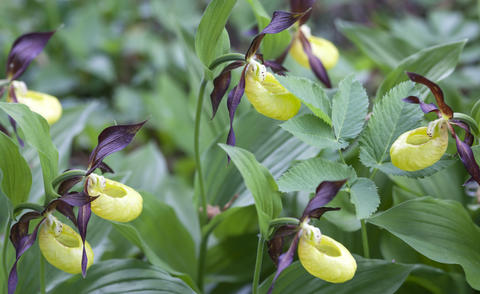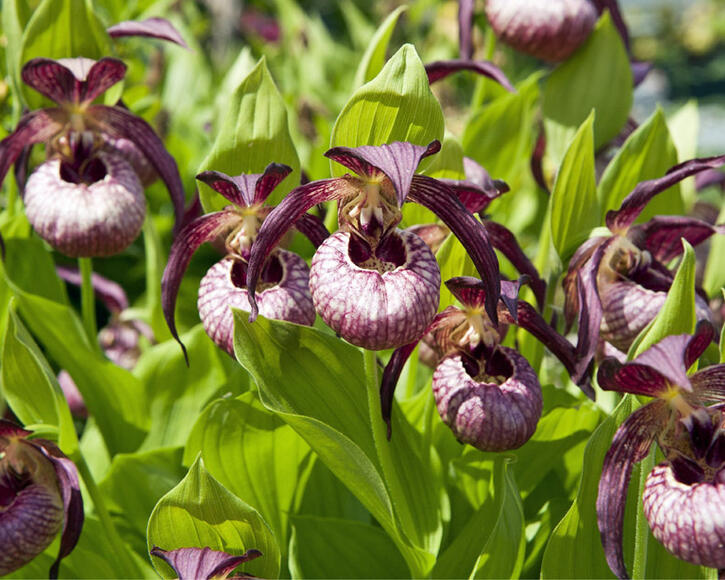Lady Slipper Orchids
Cold-hardy Lady Slipper Orchids bring exotic flair in the shaded garden. When the elegant beauties open their flowers in May they can be sure of our attention. Things that matter in planting and care.
Factsheet
- Growth type
-
- Perennial plant
- Growth characteristics
-
- horst-forming
- Flower color
-
- green
- yellow
- red
- white
- brown
- multicolored
- Flowering time (month)
-
- June to August
- Flower shape
-
- individually
- Cluster
- Leaf color
-
- green
- page format
-
- ovate
- fan-shaped
- Sheet properties
-
- Rosette
- Light
-
- semi-shade to shady
- Soil type
-
- stony to sandy
- Soil Moisture
-
- fresh to humid
- Nutrient requirements
-
- moderately nutritious
- Decorative or utility value
-
- Flower Decoration
- picturesque growth
- Winter Hardness
-
- hardy
- Use
-
- Flowerbeds
- Underplanting
- Rebates
- Garden style
-
- Flower garden
- Stone Garden
- Bee Friendly
- bee friendly plant
The genus of the Ladys Slipper Orchid belongs to the orchid family (Orchidaceae) and comprises about 35 terrestrial orchid species (). They grow primarily in the temperate areas of the northern hemisphere as well as in South Asia and Mexico. The majority of the species are endangered due to illegal trafficking or destruction of the natural habitat.
Lady Slipper Orchids are perennial and herbaceous plants that grow terrestrially. This means that, unlike most other, Orchids they grow on the ground and are therefore not epiphytes (epiphytes). Each rosette of leaves in the Lady's-slipper orchid produces only one flowering shoot. Then new rosettes then form on the leaf axils, which bloom the following year.
The egg-shaped and fan-shaped green leaves of the Lady Slipper Orchids are arranged spirally or in opposite directions.
The flowers appear individually in summer or in clusters, which are composed of up to twelve flowers. The individual flower consists of four spreading sepals (tepals) and a slipper-shaped lip. Depending on the type and variety, they appear in white, yellow, green, brown or in different shades of red, often they are also streaked, spotted or striped.

Since Lady's-slipper orchids are forest plants, they prefer cool, shady conditions and also thrive on the north side of the house. The location must not be too dry.
Ideal is a loose not too dry soil in which no waterlogging occurs. Heavy and clayey soils can be loosened using broken expanded clay (for example Hydroponics from specialist shops), sand or pumice gravel.
Fall is the best time to plant them in the garden, when the Lady Slipper Orchids are in the dormancy phase. Dig a ten centimeter deep hole and spread out flat the roots of the Lady's-slipper orchid. The bud from which the new shoots grow next year should be planted with only a 0.8 inches high soil covering. Fill the soil loosely and - most importantly - do not press it in. In the end, water the newly planted Lady's-slipper orchid. Once firmly rooted, it grows up to be a stately plant in a few years. As long as they are horticultural crosses (hybrids) and not wild species, you will enjoy these exclusive shade perennials even without special knowledge
In fall you can let the fallen leaves remain where they are. Do not place Lady Slipper Orchids too close to large trees, as the competition for the nutrients in the root area is too great. The Lady's-slipper orchids are fertilized in spring with normal mineral or garden fertilizer. Frost-hardy plants do not need winter protection. They need to be watered regularly in the hot summer months. Waterlogging should be avoided at all costs.
To propagate Lady Slipper Orchids, you can carefully divide and replant the perennials in spring. When replanting, don’t forget to take a bit of the old soil around the root ball and mix it with the new soil. It has essential symbiotic fungi that the plants need to thrive.
Lady Slipper Orchids are suitable for shaded stone gardens, peat beds or wooded gardens. A word of caution: Trees or large shrubs with an aggressive root system are not good neighbors. Compatible plants are Witch hazel (Hamamelis), Buttercup Winterhazel (Corylopsis), low ferns and shrubs like Caucasus forget-me-nots (Brunnera) and small-sized hostas (Hosta).
Specialist plant nurseries offer Lady Slipper hybrids with different flower colors from their own breeding. This ensures that the strictly protected Lady's-slipper orchids are not illegally removed from the natural habitat.
“Ventricosum” is a hybrid with ivory colored blossoms. It will form larger clumps within a few years. The Lady Slipper Orchids ‘Ventricosum’ is eye-catching because of its broad leaves and strong stems.
The multi-branched Ladys Slipper hybrid “Gisela” is particularly frost-hardy and robust and grows to a height of 11.81 to 17.71 inches. Elf flowers, Hostas or Ferns have similar location requirements and are beautiful next to their large purple-pink flowers. The variety 'Hank Small' forms dainty flowers, which resemble the native wild form in their play of colours.
Lady Slipper Orchids are propagated by dividing the root ball (see “dividing" on top).
A big problem with Lady Slipper Orchids are - as with many other perennials – slugs. Therefore, you should protect the sprouting plants in good time from damage in the spring, for example by spreading slug pellet.





